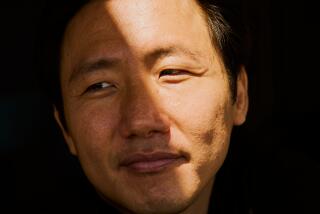Review: As a spy thriller, ‘Man From U.N.C.L.E.’ is stylish but shallow
- Share via
“The Man From U.N.C.L.E.” is now a movie, and very much a movie-movie. That is, it exists entirely within the parameters of its self-created world and the world of other movies, trashy Euro-thrillers and sophisticated, high-style extravaganzas, and not a world in which real people might actually live.
This is neither a positive or negative on its own, but in the hands of director and co-writer Guy Ritchie, it all winds up feeling hollow and even slightly oppressive, an enforced sense of fun jabbed within quotation marks. It aims for a silky lightness of touch but lands like a dropped slab of concrete.
The film is an adaptation of the popular 1960s television series of the same name, which came out in the post-James Bond era of Cold War espionage, gadgetry and international glamour. The film stars Henry Cavill as American agent Napoleon Solo and Armie Hammer as his Russian counterpart, Illya Kuryakin, the pair thrown together to team up for a mission to stop a power-mad couple based in Italy employing ex-Nazi scientists to build a nuclear weapon. There is also a girl, of course, in the form of an East German auto mechanic, played by Swedish actress Alicia Vikander, whose estranged father is one of the scientists.
SIGN UP for the free Indie Focus movies newsletter >>
The film’s Cold War early ‘60s setting is both essential to the original story and also a real hindrance to Ritchie and co-screenwriter Lionel Wigram, as the story lacks the basic tension that might once have innately existed in the proliferation-age antagonism of pairing American and Russian agents to fight a mutual opponent. (The stock use of Nazi villainy also feels uninspired.) There are certainly kicks to be had in watching beautiful people in glamorous clothes in luxuriously exotic Mediterranean locations, hopping among speedboats, helicopters and race cars, but the film’s pleasures are all surface and fleeting.
The film seems to be following the same essential formula as Ritchie’s successful “Sherlock Holmes” pictures, to take a vintage story set in the past and shoot it essentially as a modern story, with fancy contemporary effects and camera tricks, quippy dialogue and stylized costumes and sets. The biggest distinction between the two makes the new film feel like some kind of unintended treatise on the indescribable essence of movie stardom, as Cavill and Hammer are no Robert Downey Jr. and Jude Law.
Cavill, best known for his recent turns as Superman, makes out the better of the film’s two leads. His Napoleon Solo is a criminal pressed into service for the U.S. government, and Cavill captures the slightly begrudging air of someone simultaneously enjoying and annoyed by his work. Hammer’s Russian accent comes and goes, and although his seemingly native state of awkward stiffness is a bonus for the character, it does not make him a dynamic screen presence.
The story struggles to figure out what to do with the lead female character of Gaby Teller and, in turn, Vikander, seen earlier this year in “Ex Machina.” The story strains to give the character something to do besides appear in a series of mod-ish outfits, and Vikander too often seems sidelined, as in one sequence where Hammer and Cavill are off for a spectacular action set-piece and she is left alone to make a mysterious phone call in a hotel room.
As one half of the couple who make up the film’s lead villains, Elizabeth Debicki, who likewise turned heads in “The Great Gatsby,” more or less steals the movie. With a mix of glamour and ambition, Edie Sedgwick crossed with Eva Peron, she has a quality that is both knowingly ironic and yet still unapologetically committed. A moment when she folds herself down atop the back of a couch to hover over Cavill, all architectural limbs and flowing fabric, is a marvel.
The production design by Oliver Scholl and costume design by Joanna Johnston do much toward creating the world of the movie, with beautiful architecture, streamlined yet still clunky technology and eye-popping patterns. Yet it is composer Daniel Pemberton who in some ways seems to understand the idea of the movie even better than Ritchie, his score featuring breathy flutes, twangy guitar, spooky harpsichord and pounding drums and organ capturing the mixture of pastiche, homage and a twist of the new in a way the rest of the film rarely matches.
This being a modern studio would-be franchise blockbuster, there is a final beat that sets up a next adventure — the film’s stylized closing credits already seem like the start of a new movie. Ritchie’s “The Man From U.N.C.L.E.” sets itself the impossible mission of being at once fleet, witty and ironic and also big, flashy and rousing. Being a mildly pleasant, passingly amusing light entertainment isn’t exactly saving the world, yet the film crosses its wires to blow up even that modest assignment.
Follow me on Twitter at @IndieFocus and subscribe to my Indie Focus film newsletter
---------------
‘The Man From U.N.C.L.E.’
Running Time: 1 hour, 56 minutes
Rating: PG-13, for action-violence, some suggestive content and partial nudity
Playing: In wide release
ALSO:
Peter Bogdanovich still loves old Hollywood — he’s just funny that way
Lola Kirke steps out of sister Jemima’s shadow in Noah Baumbach’s ‘Mistress America
More to Read
Only good movies
Get the Indie Focus newsletter, Mark Olsen's weekly guide to the world of cinema.
You may occasionally receive promotional content from the Los Angeles Times.











